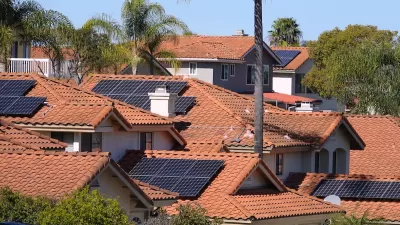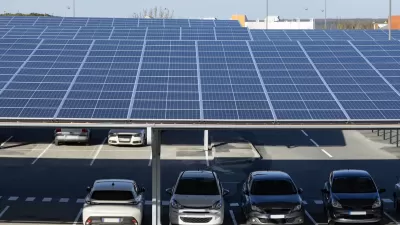In the last week to sign bills, Gov. Jerry Brown signed AB 327 that allows utilities to charge all ratepayers for costs incurred to the grid by rooftop solar and allows those who have it to 'run the meter backwards', known as net metering.
Chris Clarke explains the controversy behind AB 327. It allows utilities to charge a fixed fee of up to $10 "to recoup what they claim are costs unfairly incurred in providing rooftop solar customers backup power during times when their solar panels aren't producing power". The charge was opposed by those who saw it as regressive and unrelated to the power consumption of the household or presence of rooftop solar. However, as the governor noted in his signing message (PDF), it allows the Calif. Public Utility Commission to design new rates to give discounts to low-income households.
Solar owners will benefit with the removal of the state's net metering cap, currently "5 percent of each utility's average peak power demand", that will ensure new customers for the state's solar installation industry. Consequently the Solar Energy Industry Association "applaud(ed) Gov. Brown for his unwavering commitment to clean energy"
Under current arrangements, rooftop solar owners may not receive the full financial benefit of their system. AB 327 changes that billing system to the benefit of the homeowner.
Under net metering arrangements (also called Net Energy Metering, or NEM), rooftop solar owners can run their electric meters backward when their solar panels are feeding excess energy into the grid.
Brown also signed AB 217 that "extends two programs designed to help lower-income Californians go solar", one being for multi-family housing. Funding comes from "channel(ing) 10 percent of the California Solar Initiative's (CSI) funding toward helping California's poorest residents go solar.:
Under the programs, very low income households can get solarized with a subsidy paying all the costs. A sliding scale reduces the subsidy for people with more resources.
The CSI would have exhausted its funding in 2016. It will now be extended for another five years.
FULL STORY: California Governor Signs Controversial Solar Bill, Among Others

Alabama: Trump Terminates Settlements for Black Communities Harmed By Raw Sewage
Trump deemed the landmark civil rights agreement “illegal DEI and environmental justice policy.”

Planetizen Federal Action Tracker
A weekly monitor of how Trump’s orders and actions are impacting planners and planning in America.

Why Should We Subsidize Public Transportation?
Many public transit agencies face financial stress due to rising costs, declining fare revenue, and declining subsidies. Transit advocates must provide a strong business case for increasing public transit funding.

Understanding Road Diets
An explainer from Momentum highlights the advantages of reducing vehicle lanes in favor of more bike, transit, and pedestrian infrastructure.

New California Law Regulates Warehouse Pollution
A new law tightens building and emissions regulations for large distribution warehouses to mitigate air pollution and traffic in surrounding communities.

Phoenix Announces Opening Date for Light Rail Extension
The South Central extension will connect South Phoenix to downtown and other major hubs starting on June 7.
Urban Design for Planners 1: Software Tools
This six-course series explores essential urban design concepts using open source software and equips planners with the tools they need to participate fully in the urban design process.
Planning for Universal Design
Learn the tools for implementing Universal Design in planning regulations.
Caltrans
Smith Gee Studio
Institute for Housing and Urban Development Studies (IHS)
City of Grandview
Harvard GSD Executive Education
Toledo-Lucas County Plan Commissions
Salt Lake City
NYU Wagner Graduate School of Public Service





























